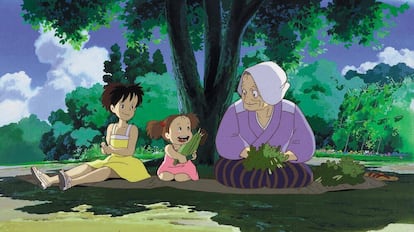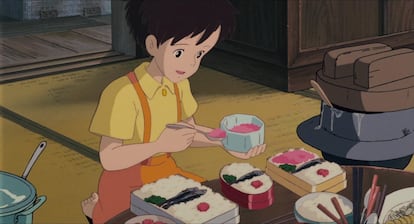—You have to wait three minutes.
That is the exact time for the magic that is cooking inside two covered bowls of ramen to unfold. This is how little Sosuke warns Ponyo, a fish-girl who is about to become completely human when she lifts the lid and a dish appears before her that will awaken her five senses, but also the very human need to share the experience. .
If this famous sequence of Ponyo on the cliff (2008) has remained engraved in the retina of the millions of followers of Ghibli films because, far from being a child’s play, it perfectly condenses the decisive role that food plays in the creations of the Japanese studio.
That food is a prominent element in Japanese audiovisuals is known to everyone. The issue has given rise to dozens of specialized publications and recipe books, such as that by Thibaud Villanova and Bérengère Demoncy. The kitchen in Ghibli (Hachette, 2023), or that of the Minh-Tri Vo group Recipes from movies Studio Ghibli (Col&Col Ediciones, 2021), and has even caused many of his followers to venture to imitate dishes taken from his best-known films. Its geometric shapes, striking colors and brightness fascinate, which has given rise to talk of a true food porn Japanese, which, far from being an abstract concept, even has a specific channel on the popular adult content platform PornHub.
But, beyond sinuous appearances and blinding flashes, we discover that, in the case of the films made by Studio Ghibli, the food is not only a sensory attraction, but rather plays a key role, both in the construction of the story and, especially, for the vital development of the characters.
Food, a sign of identity and openness
As a narrative resource, food is essential to situate the adventures of the protagonists in space and time. Often located in imaginary places, the dishes that the characters prepare or taste suggest specific territories, such as the Nordic world through the herring and pumpkin pie in Nicky, witch’s apprentice (1989) or the orange cake topped with clotted cream which takes us directly to a distinguished British home in Haru in the cat kingdom (2002). Special mention deserves the plate of spaghetti washed down with a glass of red wine that the protagonist of Porco Rosso in the workshop of Paolo Piccolo and his workers, all women, while their seaplane is being repaired. Obviously, that lunch takes us to Italy, but not to just any Italy, but to the Free State of Fiume, established in 1920 by Gabriele D’Annunzio and annexed to Italy by Mussolini, and which, after the Second World War, passed into the hands of Yugoslavia, thus recovering its original name: Rijeka, in present-day Croatia. The reason for such a peculiar choice may be found in the year of production of the film, 1992, that is, in the midst of the Balkan wars, which, without a doubt, served to amplify the pacifist message of Miyazaki’s work.

In Ghibli films, food also helps place the action at specific moments in history, even more precisely in the case of Japan, emphasizing the unique process of opening that the country experienced throughout the 20th century. . It is thus revealing that Jirō Horikoshi, the engineer who designed the fighter plane Zero and protagonist of The wind rises (2013), is encouraged by a companion to abandon his mackerel-based diet and eat meat, uncommon in the Japanese diet until the early 20th century.
This inexorable process of opening can be seen through other culinary details in the Japanese studio’s films, often with a certain skepticism and irony. This is shown, for example, by the funny sequence of The memories of yesterday (1991), set in the 1960s, in which the protagonist family experiences the arrival of the pineapple at home as an event. Enthusiastic about the exotic fruit, confusion immediately arises (“And how do you eat this? And how do you cut it?”) and, finally, a certain disappointment (“It doesn’t look anything like the one in the can”; “The bananas are much tastier.” If in the sixties it was exotic fruits that burst into Japanese homes, in the seventies the hamburgers of the McDonald’s chain entered, which opened its first establishment in the country in 1971. Their presence helps to place the action of Short (1994), starring raccoons who fight against the destruction of their habitat, threatened by the construction of housing on the outskirts of Tokyo. With an evident ironic tone, the gluttonous protagonists, despite their vindictive nature, cannot help ending a meeting by pounced on a sack full of hamburgers from the American chain.

The taste for Western food reaches even the oldest generations who, in the nineties, were seduced by recipes with unpronounceable names. Like the comedian’s grandmother My neighbors the Yamadas (1999) who, fed up with sushi, takes a risk with a beef Stroganoff. Before the astonished look of his daughter, he explains, with false confidence, that “the strophagov prepares with strophagovwhich is the most tender part of the cow.” Of course, things end badly. “You better order the sushi,” the grandmother finally exclaims dejectedly.
Food for the body and soul
Along with the use of food as a distinctive sign of a place or time, Ghibli films constantly reflect on the importance of food not only for individual well-being, but also for the community. The sequences starring the act of eating are often a hymn to frugality and simplicity, to commensality and to the bond that arises with the simple gesture of sharing a bite.

No one better expresses the benefits of simple food for the body, but also for the spirit, than the elderly neighbor of the protagonists of My neighbor Totoro (1988) when, in front of his humble harvest of tomatoes, ears of corn and cucumbers, he exclaims: “They have received the heat of the sun for a long time, that is why they are so good for the body and the soul,” and he concludes by pointing out: “The garden can make anyone feel good right away.”
The almost magical character that these beautiful words give it reaches a literal meaning in several Ghibli stories, where eating some foods represents a physical transformation of the characters. The most paradigmatic case is the parents of Spirited Away (2001), punished to become pigs for voraciously gobbling up the tasty food destined for the gods.
Faced with the havoc that selfish gluttony entails, moderation and commensality become almost a moral issue. What nourishes correctly is what is simple and, above all, what is shared or prepared with the objective of caring for others. The gorgeous bentō that the protagonist of My neighbor Totoro At only 11 years old, he prepares his little sister, okayu (replenishing rice porridge) that the wandering monk Jiko offers to the male protagonist of Princess Mononoke (1997) or the onigiri magic with which Haku comforts Chihiro and saves her from transforming into a pig like her parents, are just a few examples of the beauty that lies in the simple gesture of offering a snack. In doing so, these dishes seem to uncover a universal truth: when returning from a battle or celebrating a new beginning, nothing is more comforting than a shared plate of food.

